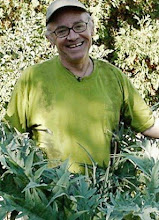




The calendar indicated spring but this morning the snowfall seemed to indicate something else. With the greenhouse running (meaning heated) I worked this week on several seeding several crops. Ornamental annuals, Coleus and Nicotiana, were planted and put on the heating mats. Bottom heat is really essential for a number of seedlings especially the peppers and tomatoes but also most annuals who like warm soil germination temperatures. I am researching a new set of mats as the ones I have just don't seem to be as reliable as I would like.
This week's pictures show my seeding methods for onions, and the video shows the deep plastic trays that I early seed for micro-greens. I also started lettuce seed and will continue to plant lettuce all season long. Lettuce is an ideal transplant for empty spaces in a garden at all times so I like to have plants ready and waiting. You will notice that I have top dressed with two different sterile materials to help prevent damping off. I am using a fine vermiculite and milled sphagnum moss. The seeding season will be an experiment to see which I like and which seems to perform the job of protecting my seeding from the fungus.
I seed onions in community flats for later planting out in the garden just like set onions. The flats are filled with a potting soil, lightly tamped and multiple rows are marked in each flat. Seed can be scattered thick or evenly spaced. I usually plant thick and then transplant into the garden as bunches and thin as I harvest. However, this year I have some larger storage onions, Trailblazer and Alisa Craig, that I want to harvest so those were seeded spaced. When I am ready to plant these seedlings I will make a video as to how I get them out of the community flats and into the ground. I also planted a seed variety of Shallot called Olympus Hybrid. We are still using seeded shallots from last year in the kitchen so I am looking forward to this as another shallot for kitchen use.
I also planted lettuce (Tom Thumb, Simpson Elite, Winter Density, Red Derby). Seed was put into nine packs and the older the seed the more I planted. I do have one variety, Red Derby, a Boston type that is pelletized for easier seeding. I like this because I can put an exact amount of seed in each cell and that makes thinning much easier. Lettuce seeds do not get put on heat mats as they seem to germinate better without bottom heat and a cooler location in the greenhouse, sometimes out of the direct light. I also planted two types of Parsley, curly leaf and an Italian. Both seeds were hot water treated ( a way to help speed up germination a bit) and then seeded into nine packs. I planted more curly leaf than Italian because we use the curly leaf as part of the landscape planting as edging. But the Italian is what I cook with because of the nice strong flavor. This seed will take a long time to germinate (15-20 days) so I have to be patient.
This weeks video is the planting of micro-greens that went into a large plastic, wallpaper, tray that will get me an early crop of Mesclun, Arugula, and radish. The trays are never filled with more than 4-5 inches of soil so that later in the season they can go outside to finish growing as the weather cooperates. The seed is either planted in rows or scattered, and in this case some lettuce was spot planted in between the rows of greens.
Earlier this week, on one of our warm sunny days, I did clean one cold frame and plant spinach in a third of the space leaving the other empty soil for later plantings to lengthen my harvest time.
A productive week seeding but there is much more to plant. I hope to work on some cold frame plans for next weeks post. Building two of theses season extenders in the next few week would be a good idea as these seedlings will soon crowd my space in the greenhouse and need to be hardened off outside.
Happy Gardening











